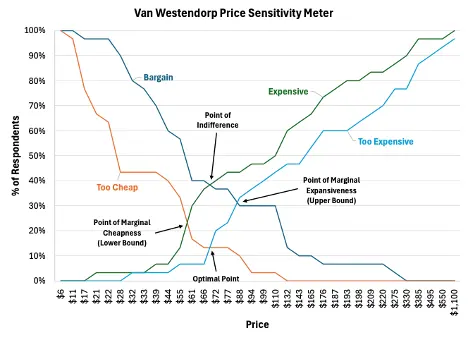Develop an Effective Pricing Strategy
Most companies struggle to set optimal price points for software and SaaS products. A recent survey showed that 85% of B2B companies have significant room to improve their pricing. There’s real potential to leave millions on the table due to underpricing because it’s difficult to know if prices are too low. It’s generally easier to see when prices are too high because deals stall or sales teams rely on steep discounts.

Adjusting prices is complex and can significantly impact business momentum and cash flow margins. Increasing price for example can lead customers to expect significant changes in the value proposition, product roadmap, and end-to-end customer experience.
In this blog we’ll explore how to develop and execute an effective pricing strategy in six steps:
- Define Your Value Metric and Price Model
- Define Your Customer Value Proposition
- Research Customers’ Willingness to Pay and the Competitive Landscape
- Determine Your Costs
- Align Sales and Marketing
- Test, Adjust, and Continuously Monitor
1. Define Your Value Metric and Price Model
Value Metric
A value metric is what you charge per unit or user for your product. It determines the product price and subscription terms. It should be based on what customers value most in the product, for example, the core features that they can’t live without. It should also be intuitive and make sense to customers.
Basing the value metric on what customers value most encourages them to get more value out of the product by purchasing additional units. Your value metric in turn will grow with the install base, maximizing your revenue and profit potential.
Some common examples of scalable value metrics include:
- Usage Based – per user, device, video hosted, bandwidth, or API call
- Outcome Based – per lead, transaction, project, task, job, or customer
- Feature Based – per tiers of features (e.g., each tier includes the features of the prior tier while unlocking additional features)
Price Model
The price model builds on the value metric to ensure optimal pricing and value delivery for different targeted customer segments. It can also aid in tailoring the customer’s experience when they’re at different points of the customer journey.
Some common models include:
- Freemium: Offer a basic version for free, with paid upgrades for premium features or higher usage limits.
- Tiered Pricing: Create multiple pricing tiers with different levels of value delivered and support. This allows customers to choose the plan that best fits their needs and budget.
- Custom Pricing: For large enterprises or complex use cases, offer custom pricing based on specific requirements and scale. This often involves negotiation.
- Soft Bundles: Offer customized bundles of products.
Mapping customer journeys can help to identify areas of potential friction caused by the price model that impede acquisition, retention, and growth.
The following examples illustrate different value metrics and pricing models:
Usage-Based
- Segment CDP: Per data tracked and processed in three tiers (Unify, Unify Plus, and Engage)
- Snowflake Data Cloud: Per amount of data stored and computational resources consumed in four tiers (Standard, Enterprise, Business Critical, Virtual Private Snowflake)
Outcome-Based
- ActiveCampaign: Per number of contacts and degree of automation in four tiers (Starter, Plus, Pro, Enterprise)
- Monday.com Work Management: Per seat, boards, automations, and integrations in five tiers (Free, Basic, Standard, Pro, Enterprise)
Feature-Based
- Salesforce Sales Cloud: Three tiered offerings with increasing number of features (Enterprise, Unlimited, and Enstein 1 Sales).
- Figma: Four tiered offerings with increasing number of features (Free, Professional Team, Organization, Enterprise)
2. Define Your Customer Value Proposition
The customer value proposition needs to align with the value metric and is key to an overall effective product strategy. It needs to clearly articulate how your product (and organization) meets the needs of your customers and addresses their pain points, and what differentiating benefits and advantages the product delivers compared to competitor products.
3. Research Customers’ Willingness to Pay and the Competitive Landscape
Willingness to Pay
Pricing research allows you to develop and understand customer segments (and personas) to build a pricing strategy optimized for the right segments and price points that maximize your revenue and/or margin potential.
Not all customers will exhibit the same willingness to pay. Segmenting and prioritizing customers willing to pay more than others will help focus sales, marketing, and product discovery efforts for maximum impact. Conversely, it’s also important to understand customers whose willingness to pay is too low that they’re not worth targeting.
A popular technique for researching customers’ willingness to pay is to simply ask them by using the Van Westendorp Price Sensitivity Meter. It’s a short, four-question survey that determines the price points that customers find are too cheap, a bargain, expensive, or too costly.
The four questions to ask each customer segment are:
- At what price do you think the product is priced so low that it makes you question its quality?
- At what price do you think the product is a bargain?
- At what price do you think the product begins to seem expensive?
- At what price do you think the product is too expensive?
You can leave the answers open-ended (e.g., ask respondents to fill in a price but make sure to only allow numerical responses) or let respondents select from a price range.
The collected price points are plotted on a chart, and the optimal price is the point at which the Too Cheap and Too Expensive lines cross. Some of the other lines’ intersections provide an estimate of the lower and upper bounds of what customers are willing to pay.
The following chart illustrates an example Van Westendorp Price Sensitivity Meter:

While simple, inexpensive, and quick to execute, there are some flaws in this method to consider:
- It’s a theoretical technique that focuses only on prices and only on a hypothetical scenario. It ignores other key factors in purchase decisions such as brand, features, and competitor prices.
- Respondents may game the survey to get you to set lower prices.
- The technique requires respondents to be well-informed and well-versed in the product, and possess as much detailed product information as possible, so it may be ineffective with new products as responses may cover an unrealistic range.
Competitive Landscape
Benchmarking the pricing models of competitors will provide you with an understanding of industry standards and options from the customers’ perspective, and useful references for determining your pricing model. Researching the pricing model of peer, non-competitor products can help you learn from others and help you ideate new options.
4. Determine Your Costs
The total cost of your product is the sum of the cost to serve and support customers and the customer acquisition cost (CAC). The cost to serve and support customers includes the cost of development, maintenance, cloud, customer support, tools, and any partnerships.
CAC includes the average cost of marketing, sales, and tools spent on acquiring new customers. It’s a measure of the effectiveness of sales and marketing efforts in acquiring customers. If the CAC is too high, it means you’re spending more on acquiring customers than they’re worth to your business. If it’s low, each customer is generating enough revenue to cover the cost of acquiring them. CAC also helps to determine the average break-even point of the customer, when your organization starts to generate a profit.
Understanding these costs helps to ensure prices will cover the costs and offer the profit margins required by your company.
5. Align Sales and Marketing
Sales and marketing help to create a suitable image of the product for customers, and pricing must be congruent with this image. Pricing needs to align with and reinforce how customers perceive the product and its differentiation from competitors.
Ensure that your sales and marketing teams understand pricing insights, value metric, pricing model, and overall pricing strategy. Sales will be enabled to effectively communicate the value proposition to customers and marketing will be enabled to clearly articulate pricing and its benefits in marketing content.
6. Test, Adjust, and Continuously Monitor
Combining research with testing can help you better understand why your pricing strategy is performing the way it is.
A/B testing price options can help you evaluate current price or price models with a new option to see which performs better. You’ll need to define the specific change to be tested, select the metric that you think will improve, and predict by how much the metric might change. You should also ensure that no changes are made in marketing or the product during price testing so that results are based only on price variation.
Defining SMART objectives can help you clearly define the test, for example:
- Specific: Increase MRR by 6%.
- Measurable: Track MRR and leading indicators such as conversion or drop-off rates.
- Achievable: Based on historical data and competitor/peer benchmarks.
- Relevant: Aligned to business goals such as driving growth or profitability.
- Time-Bound: Run the test for 6 weeks, for example.
Instead of A/B testing, you can pilot a specific pricing model in a specific region or test only the pricing web page.
When you’ve selected, tested, and implemented your optimal pricing strategy, regularly review the strategy to ensure pricing is still optimal. Monitor key performance metrics such as customer acquisition cost (CAC), lifetime value (LTV), churn rate, sales volume, revenue growth, and profitability to continuously assess the effectiveness of your pricing strategy, and stay attuned to changes in the market, technology, competitors, and customer needs to adjust your pricing strategy as necessary.
Conclusion
In summary, take the following steps to develop and implement an effective pricing strategy to achieve your organization’s business objectives:
- Define Your Value Metric and Price Model to define the most valuable product metric from the customer’s perspective and define how to scale growth and remove friction in the buyer’s journey.
- Define Your Customer Value Proposition in alignment with your pricing strategy.
- Research Customers’ Willingness to Pay and the Competitive Landscape to understand the boundaries of acceptance within each customer segment as well as industry benchmarks.
- Determine Your Costs to know how much it costs to drive revenue.
- Align Sales and Marketing to effectively communicate the customer value proposition.
- Test, Adjust, and Continuously Monitor to adapt to changing conditions and customer preferences over the long term.